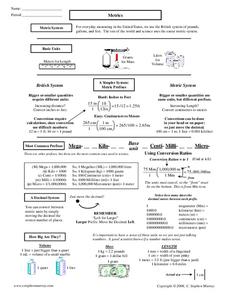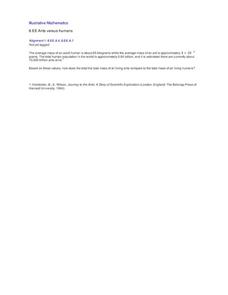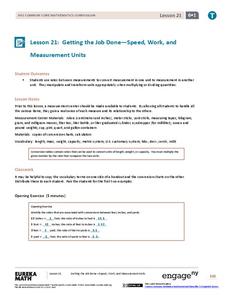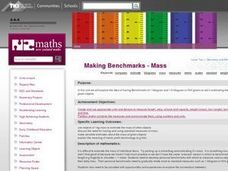Curated OER
Measuring Weight
Students use tables showing the ratios between ounces and pounds, grams and kilograms, and pounds and kilograms. They estimate whether an object should be weighed in ounces or pounds and whether an object should be weighed in grams or...
Curated OER
Practice with Mass
Fourth graders investigate the weight/mass of a number of items using grams, and equivalents. They examine the use of a triple beam balance before massing objects including oil and water. They go over the weights they amassed and weigh...
Curated OER
Metrics
In this metrics worksheet, learners read information about the metric system. Students review the concepts of prefixes, conversion ratios, and the decimal system. This worksheet has 17 matching, 31 fill in the blank, and 8 word problems.
Curated OER
Problem Solving: Metric Conversion
Using a table, students solve 12 word problems about the weights of various foods at the grocery store. The solve addition and subtraction problems as well as convert kilograms to grams.
Curated OER
Converting Frenzy
Gain practice converting between metric units of volume and mass. The class goes over the procedures for making the conversions as a whole. The strategy used here includes making charts that show the relationships between the...
Curated OER
Convert Metric Units of Capacity and Mass
Use this converting metric units worksheet to have your learners solve six word problems where they covert metric units of mass and capacity in order to arrive at an answer.
Illustrative Mathematics
Ants Versus Humans
You would think that humans make up more mass than ants do on this planet, but think again, and this time by performing calculations. Middle schoolers use scientific notation to compute and compare the estimated total mass of all humans...
Curated OER
Busted Bubbles
Using the scientific method, and bubble gum, learners conduct a motivating experiment. After conducting a series of tests involving bubble gum, they graph and analyze their results. This is the type of activity everyone loves.
Alaska Department of Education
Mathematics Reference Sheet
Triangles and prisms don't stand a chance when your learners use this handout full of the formulas they need to know about the different shapes. Area, volume, and surface formulas are all covered along with the standard measurement and...
Curated OER
Making Simple Conversions
Young scholars explore the concept of measurement as it relates to equivalencies. They complete simple conversions using visual models of measurement units, and record their answers in a two-column table.
Kenan Fellows
Analyzing Speed from Different Modalities
Show us your moves. Using sensor equipment, scholars track the motion of different movements, such as jogging, skipping, or jump roping. They analyze velocity and acceleration and create graphs representing each movement.
Curated OER
Measure Mania
Groups of students rotate through five classroom stations to estimate, measure, and record volume, length, weight, mass, and area using both customary and metric measure. They evaluate their data to determine how close their estimates...
EngageNY
Getting the Job Done—Speed, Work, and Measurement Units
How do you convert from one measurement to another? Pupils use unit rates to convert measurements from one unit to another in the 21st segment in a 29-part series. They convert within the same system to solve length, capacity,...
Curated OER
Reversals with Multiplication and Division
In this mathematics worksheet, students read the table that shows the answer to the cost per kilogram when 3.678 kg of a product costs $14.89 rounded to the nearest cent. They complete the table and round where necessary for each problem.
Curated OER
Adding and Subtracting Weights
For this online math worksheet, students practice adding and subtracting metric weight values. This excellent resource allows the students to check their answers, and to get "hints" should they run into difficulties. A terrific teaching...
Curated OER
Metric System
Learners solve problems using the metric system. In this algebra lesson, students convert between the metric system and the Imperial system. They use these two systems to solve real life problems.
Curated OER
Making Benchmarks - Mass
Elementary schoolers predict the mass for different objects. Then, using objects of 1kg mass, they make a more precise prediction. Afterwards, they discuss the need for having and using standard measures of mass.
Curated OER
Unit 0 Review - Measurement Lab Equipment
Review questions like these can be used in your biology, chemistry, physics, or earth science classes! They assess scientists' understanding of laboratory measurement tools including graduated cylinders, thermometers, and balances. They...
Curated OER
Tick Around the Clock
Students examine and discuss the differences between clocks they are shown. Using the internet, they research how people used to tell time before clocks. They review what the long and short hand on the clock represent and practice...
Curated OER
Mass, Volume, and Weight
Students explore mass, volume, and weight. In this science and measurement instructional activity, students compare volume, mass, and weight after listening to the teacher's description of each. Students explore different scales and...
Curated OER
The Metric System
Students convert measurements within the metric system. In this measurement lesson, students explore the different units of the metric system and practice converting numbers from one unit to another.
Curated OER
Can You Relate?
In this measurement conversion post test worksheet, students must complete the ten multiple choice questions by using conversion formulas. Students convert various measurements such as miles, feet, days and years.
Curated OER
Observing and Identifying Matter
In this observing and identifying matter worksheet, middle schoolers use a cookie in a bag and list 10 different descriptions of the cookie. They draw and label their cookie and given the cookie in the bag to their teacher who mixes all...
Curated OER
Using CM and MM
In this measuring lines worksheet, students measure 6 lines and write the answers in centimeters and millimeters. Students measure 10 other listed objects and give their answers in large and small units.

























